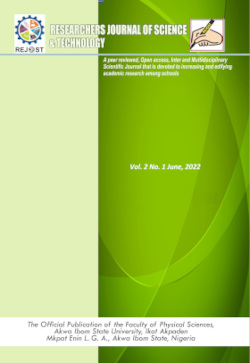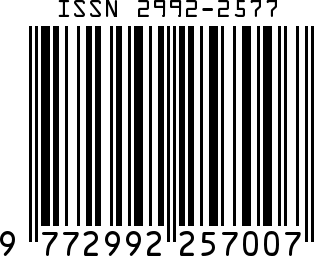Gas chromatography - mass spectrometry characterization and antibacterial activity of stem-bark extracts of Dacryodes edulis (African pear)
Keywords:
Antibacterial activity, Dacryodes edulis, metabolites, PhytochemicalsAbstract
This study investigates the antibacterial activities of the stem bark extract of Dacryodes edulis. The aim of the study was to deduce the potency of the crude extracts and their metabolites from stem-barks of Dacryodes edulis on drug-resistant microbial pathogen(s). The stem bark of the plant was extracted with five solvents of different polarities. While extraction with hexane, dichloromethane, ethyl acetate, and methanol were done using a soxhlet extractor, aqueous extract was obtained by soaking 250 g of powdered samples in 200ml of distilled water for 18 hours The five plant extracts were subjected to phytochemical screening that revealed the presence of alkaloids, flavonoids, carbohydrates, tannins, saponin, steroids, and triterpenes. The bioactivity of the extracts at varying concentrations of 250 mg/mL, 200mg/mL, 150 mg/mL, 100 mg/mL, 50 mg/mL and 25 mg/mL were determined. Based on the result of the bioassay, the most active extracts were partitioned into acidic, basic, and neutral metabolites and the bioactivity tests were repeated on the metabolites. The extracts elicited antibacterial activity against all the strains tested zones of inhibition ranging between 1 mm to 36 mm. The bactericidal effects of the extracts on all the microorganisms tested were positive at 250 mg/mL and 200 mg/mL. Also, the acidic, basic, and neutral metabolites of the Methanol and the Ethylacetate extracts exhibited bactericidal effects at 250 mg/mL. At 200 mg/mL, all the six samples except the neutral metabolite of the methanol extract (which was only effective against Staphylococcus Aureus, Salmonella typhi, and Salmonella Paratyphli) exhibited antibacterial activity. The gas chromatography-mass spectrometry (gc-ms) spectra revealed 4-dehydroxy-N-(4,5-methylenedioxy-2-nitrobenzylidene) tyramine and1,2{bis(2-methyl propyl)} benzene dicarboxylateas the most abundant compound in the basic metabolites of ethyl acetate and methanol extracts respectively. The most active metabolites were basic metabolites of ethyl acetate and methanol extracts. While the basic metabolites of ethyl acetate contain mostly alkaloids; the basic metabolites of methanol contain mostly terpenoids. These active metabolites possess antibacterial activity against Staphylococcus aureus and other pathogens tested.
References
Abdullah, B.M., Mehdi, M.A.H., Khan, A.R., Pathan, J.M., (2020).Gas chromatography-mass spectrometry (GC-MS) Analysis of Ajwain
(Trachyspermumammi) Seed Extract. InternationalJournal of Pharmaceutical QualityAssurance11 (2):228-231.
Abraham, Ignatious; Joshi, Rahul; Pardasani, Pushpa and Pardasani, R.T., (2011). Recent advances in 1,4-benzoquinone chemistry. Review: Journal of the Brazilian Chemical Society22(3).
Ajibesin, K.K., Essien, E.E. and Adesanya, S.A., (2011). “Antibacterial constituents of the leaves of Dacryodes edulis”. African Journal of Pharmacy and Pharmacology5(15), 1782-1786.
Akpan, I.O., Ogali, R.E., Achugasim, O., (2017). Antifungal activity of crude extract and metabolites of leaves of Enantiachlorantha Oliv. (African yellow wood), Journal of Natural Products and Resources, 3(2) 137-140.
Alves, S.H., Lopes, J.O., Costa, J.M., Klock,C., (1997). Development of secondary resistance to fluconazole in Cryptococcus neoformans isolated
from a patient with AIDS. Institute of Medical Tropical Sao Paulo 39:359-361.
Amise, A.F., Lennox, J.A., Agbo, B.E., (2016). Antimicrobial Potential and Phytochemical Analysis of Dacryodes edulis Against Selected
Clinical Bacterial Isolates. International Journal of Pharmacognosy and Phytochemical Research 8(11), 1795-1800.
Archana, R., Kanchana, G., Rubalakshmi, G., (2014). Identification of bioactive compounds from marine sponge—Spongiatostaby GC–MS analysis. World Journal of Pharmaceutical Sciences 3(11):439–445.
Chandrasekaran, M.; Senthilkumar, A.; Venkatesalu, V., (2011). Antibacterial and antifungal efficacy of fatty acid methyl esters from leaves of Sesuviumportulacastrum L. European Review for Medical andPharmcological Sciences 15, 775–780.
Devi, R.B., Barkath, T.N., Vijayaraghavan, P. and Rejiniemon, T.S., (2018). GCMS Analysis of Phytochemical from Psidium guajava Linn. leaf extract and their in-vitro Anti-microbial activities. International Journal of Pharmacy and Biological Sciences 8(1), 583-89.
Drlica, K. and Zhao, X., (1997). DNA gyrase, topoisomerase IV, and the 4-quinolones. Microbiology and Molecular Biology Reviews 61, 377–
Forbes, B.A., Sahm, D.F., Weissfeld, A.S., (1998). Bailey and Scott’s Diagnostic Microbiology, 10th edn. Mosby Inc., St. Louis Missouri, USA.
Govindappa, M., Prathap, S., Vinay, V. and Channabasava, R., (2014). Chemical composition of methanol extract of endophytic fungi, alternaria sp. Of tebebuia argentea and their antimicrobial and antioxidant activity. International Journal of Biological & Pharmaceutical
Research 5(11), 861-869.
Gupta, V.K., (2012). Comprehensive Bioactive Natural Products. Efficacy, safety & clinical evaluation II. Studium press, LLC Texas, USA, pp.
-148.
Hadi, M.Y., Mohammed, G.J., Hameed, I.H., (2016). Analysis of bioactive chemical compounds of Nigella sativa using gas chromatographymass spectrometry. Journal of Pharmacognosy and Phytotherapy 8(2), 8-24.
Jegadeeswari, P., Nishanthini, A., Muthukumarasamya, S., Mohan, V.R., (2012). GC–MS analysis of bioactive components of Aristolochiakrysagathra (aristolochiaceae). Journal of Current Chemical and Pharmaceutical Sciences 2(4):226–232.
Johanna, J., Dalziel, J., (2005). Flora of West Tropical Africa. Mill Bank, London: Crown Agents for Overseas Government Georgia 11:10.
Kengue, J., (2001). African Pear fruits. International Center for underutilized crops. Souuthampton, UK: 15-20.
Marjorie, C., (1999). Plant products as antimicrobial agents. Clinical Microbiology Reviews 12, 564-582.
McManus, M. C., (1997). Mechanisms of bacterial resistance to antimicrobial agents. American Journal of Health System Pharmacy 54: 1420-1433.
Meenakshi, V. K., Gomathy, S., Senthamarai, S., Paripooranaselvi, M., and Chamundeswari, K. P., (2012). GC-MS determination of the bioactive components of microcosmusexasperatus heller, 1878. Journal of Current Chemical & Pharmaceutical Sciences 2(4), 271-276.
Mohamed, I. E., Khalid, H. E., Mohamed, S. A., Osman, E. E., Koko, W. S., Taha, K. K., Dahab, M. M., Abdullahh, N. R.B., Ismail, Z. B. (2014). Anti-malarial activity of some medicinal Sudanese plants. Journal of Forest Products & Industries, 3(6).
Neu, H. C., (1992). The crisis in antibiotic resistance. Journal of Science 257, 1064- 1073.
Nobori, T.K., Miurak, D.J., Wu, L.N., Takabayashik, Carson, D.A., (1994). Deletion of cyclin-dependent kinase-4 inhibitor gene in multiple human cancers. Nature 368, 753-756.
Ogboru, R.O., Okolie, P.L. Agboje, I., (2015). Phytochemical Screening and Medicinal Potentials of the Bark of Dacryodes edulis (G. Don) HJ Lam. Journal of Environmental Analytical Chemistry 2(5), 1-3.
Onuegbu, N.C., Nwuka, M.U., Ojukwu, M. and Kabu, N.O., (2016). Nutritional properties of African Pear Seed and Performance of defatted Cake in Poultry Feed formulations 1(2), 9.
Petri, W.A.J., (2006). Antimicrobial agents: sulfonamides, trimethoprimsulfamethoxazole,quinolones, and agents for urinary tract infections. In: Brunton L. L, Lazo J. S, Parker K. L, eds. Goodman and Gilman‟s The Pharmacological Basis of Therapeutics, 11th ed. New York: McGraw-Hill 1111–1126.
Rahmalia, Anisa; Esyanti, Rizkita R. and Iriawati, (2011). A Qualitative and Quantitative Evaluation of Terpenoid and Alkaloid in Root and Stem of Pasak Bumi (Eurycoma longifolia Jack). Plant Science and Biotechnology Scientific Group School of Life Sciences and Technology.
Raquel, F.E., (2007). Bacterial lipid composition and the antimicrobial efficacy of cationic steroid compounds. Journal of Biochemical and Biophysical Analysis 7, 2500–2509.
Rollas, Sevim and Küçükgüzel, Ş. Güniz, (2007). Biological Activities of Hydrazone Derivatives: Review. Molecules 12, 1910 – 1939.
Saeedi, M. and Morteza-Semnani, K., (2009). Chemical composition and antimicrobial activity of the essential oil of Heliotropiumeuropaeum. Chemistry of Natural Compounds 45(1), 98-99.
Sarada K., Jothibai M.R., Mohan V.R., (2011). GC–MS Determination of Bioactive Components of Naringicrenulata (Roxb) Nicolson. International Journal of Chem Tech Research 3(3),1548–1555.
Schwender, J.,(2009). Plant Metabolic Networks. Springer Science Business Media, London.
Sharee, H.K., Muhammed, H.J., Hussein, H.M., Hameed, I.H., (2016). Antibacterial effect of ginger (Zingiber officinale) roscoe and bioactive chemical analysis using gas chromatography mass spectrum. Oriental Journal of Chemistry32(2), 20-40.
Shimada, T., (2006). Salivary proteins as a defense against dietary tannins. Journal of Chemical Ecology 32, 1149- 1163.
Soberon, J., Sgariglia, M., Sampietro, D., Quiroga, E and Vattuone, M., (2007). Antibacterial activity of plant extracts from Northwestern Argentina. Journal of Applied Microbiology 102, 1450-1461.
Storm, D.R., Rosenthal, K.S. and Swanson, P.E., (1977). Polymyxin and related peptide antibiotics. Annual Review of Biochemistry 46,723-763.
Tenover, F.C. (2006). Mechanisms of Antimicrobial Resistance in Bacteria. The American Journal of Medicine 119 (6A), 3–10.
Yao, J. and Moellering, R.J., (2003). Antibacterial agents. In: Murray P. R., Baron E. J., Jorgensen J. H., Pfaller M. A., Yolken R. H., eds. 8th
ed. Washington, DC: ASM Press, Manual of Clinical Microbiology 1039-1073.
Zablotowicz, R.M., Hoagland, R.E. Wagner, S.C., (1996). Effect of saponins on the growth and activity of rhizosphere bacteria. Advances in
Experimental and Medical Biology 40, 83-95.

Downloads
Published
How to Cite
Issue
Section
Categories
License

This work is licensed under a Creative Commons Attribution-NonCommercial-NoDerivatives 4.0 International License.




